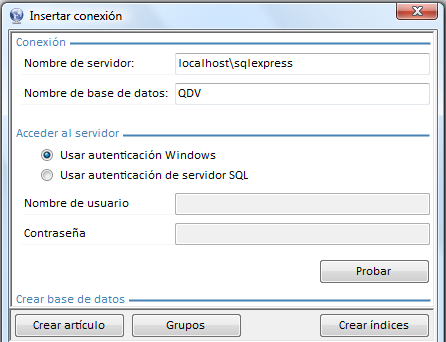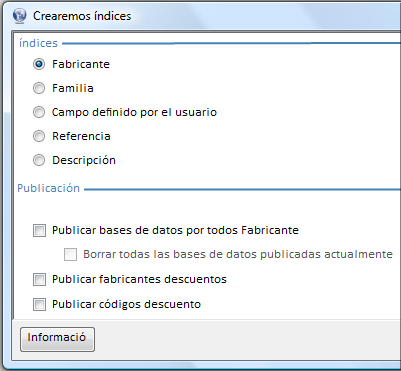Deploying an SQL database includes connection and publication.
Conexión
Para insertar una conexión con una base de datos SQL:
1.Seleccione un índice libre o uno que queramos reemplazar
2.Haga clic en Servidor; así se abrirá una ventana de conexión
3.Rellene las casillas de la ruta y el nombre del servidor
4.Rellene la casilla del nombre de la base de datos
5.Marque el tipo de autenticación; en el caso de Autenticación de Servidor SQL, salga de la sesión
6.Con la opción de Autenticación de Windows, haga clic en el botón Prueba
7.a continuación en Crear artículo; ahora, el índice tendrá el nombre del servidor para la ruta completa y tendrá un pictograma específico (un globo terráqueo)
8.To publish the database, click Create Indexes

NOTA: Con condiciones más complejas, la Base de datos de artículos sigue funcionando; no obstante, las Bases de datos de artículos trabajan con lentitud y los índices han de crearse manualmente en cada caso.
A database can be published to a local server in various ways. Para que se publiquen en QDV7, las Bases de datos ya deben contener al menos un artículo para cada Fabricante a publicar.

To insert the columns to the table to be published, check the box Add included columns.
To show the manufacturer views, marque la casilla Publicar Bases de datos por Todos los Fabricantes. Marque la casilla Borrar todas las Bases de datos actuales publicadas (opción).
The table of published databases shows in Management Studio:

Para agilizar el acceso, seleccione Crear Índices. En el cuadro de diálogo, seleccione la clave de entre los cinco campos básicos; this will delete and recreate the indexes.
For reference on indexes, visit http://use-the-index-luke.com
Performance Issues
To improve the performance of sorting/searching/filtering in the article database, include ALL the columns you use regularly in the articles viewer.
To enhance the indexes, add therein columns in addition to the key column ; as a result the indexes address more queries.
An index that includes all the invoked columns, whether a key or not, significantly improves the query performance; the physical table is not read, which results in fewer accesses to the disks.
Avoid adding unnecessary columns into indexes as adding too many columns, whether a key or not, may result in the following:
▪More disk space is required to store the index
▪Maintaining the index may increase the time it takes to perform edits such as insertion, deletion, updating
In summary, assess whether the benefits in the queries execution exceed the edition performance loss and the need for more disk space.
NOTE With more complex conditions, the Article database still works; however large Article databases work slowly and the indexes must be created manually in each case.